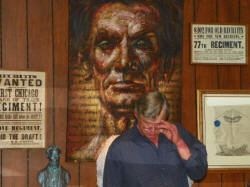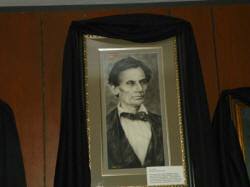|
One hundred fifty years ago this week, the
first shots were fired that began the Civil War. One hundred
forty-six years ago this
week, Lee surrendered to Grant at Appomattox Courthouse, marking the
beginning of the end of the Civil War.
A few days later, on April 14, 1865, our nation's 16th president,
Abraham Lincoln, lost his life at the hands of an assassin.
Thursday evening the Heritage Museum on the campus of Lincoln
College was draped in mourning as this museum dedicated to the life
of Abraham Lincoln remembered the loss of that great life.
On hand for the evening was Virgil Davis of Springfield, a retired
mortician who has for over 50 years collected death and funeral
memorabilia. Davis presented a one-hour talk in the Lile Lecture
Hall and shared several pieces of his vast collection, including
items related to Lincoln.
In the 1800s it was a common practice to cut locks of hair from the
dead. Most often these locks were woven or quelled into jewelry,
commonly known as mourning jewelry or decorative commemoratives.
Davis said it was the hair jewelry that first caught his
attention and began his half-century quest to collect as many
pieces as possible. Along the way his interest expanded, and today he
has literally thousands of pieces in his collection, ranging from
hair jewelry to hair samples to pieces of wood taken from the
coffins of President George Washington and President Abraham
Lincoln.
During the course of the evening, he showed pieces from his
collection to approximately 50
guests and recounted the capture and
execution of the 10 conspirators involved in the assassination of
Lincoln.
Among the pieces he shared, passing them around for the audience to
touch and examine more closely, were hair bracelets and watch fobs,
quelled hair artwork, and samples of hair from Lincoln, John F.
Kennedy, Elvis Presley and Mary Surratt; the only female involved
in the Lincoln conspiracy. He noted that immediately after she was
hung, Surratt's hair was cut and sold as souvenirs.
Several items that Davis presented Thursday evening will remain on
loan to the museum, and the public is invited to stop in and look at
everything the museum has to offer.
[NILA SMITH] |
|

This stirring portrait hangs on the east wall,
looking out on all those who visit the museum.
|

In 1860s fashion, images in the museum are draped in black
mourning cloth. |
|